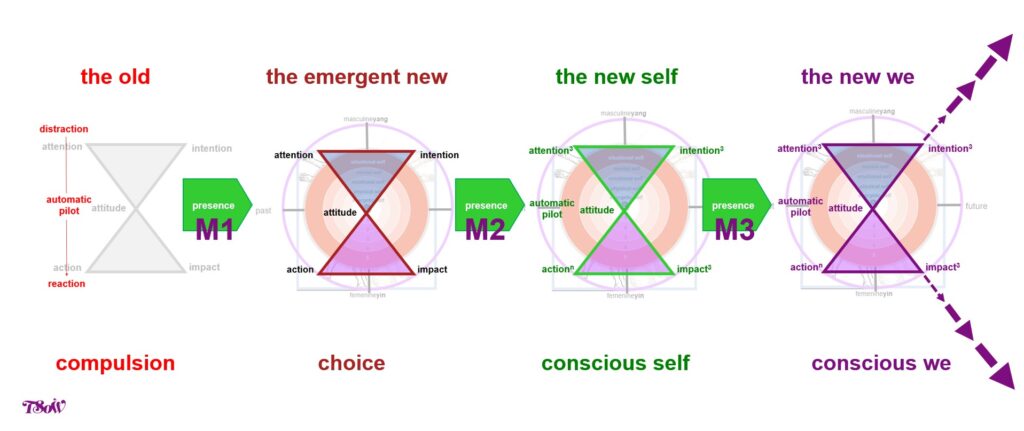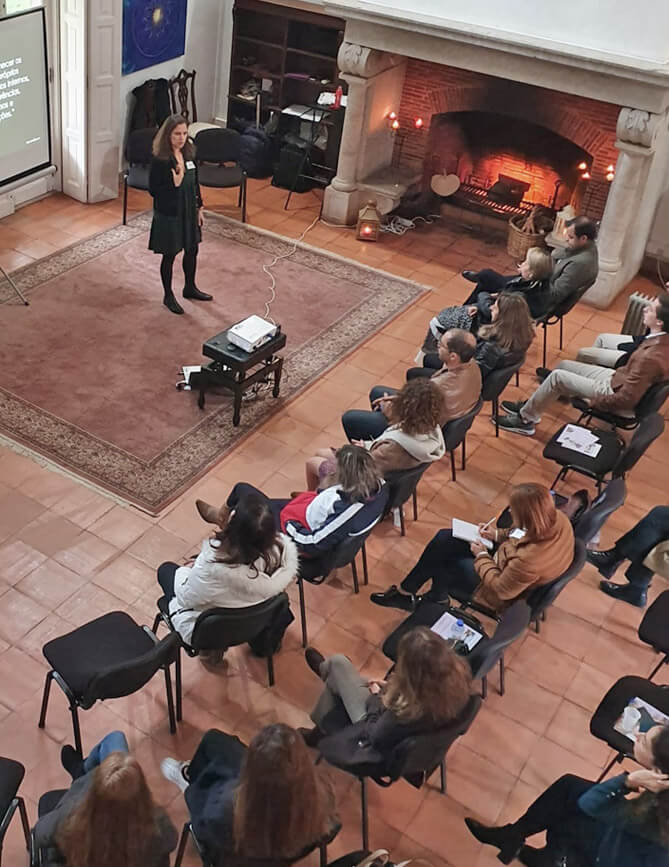“The map of the self” integrates in a single framework “the 5 levels of the self” plus “the skeleton of the self”. This framework builds order and meaning to all meditation practices that build “self-awareness”, “self-knowledge”, and “self-management”. The basic movement that we experience with a sustained meditation practice takes us from a distracted, unaware form of the self towards an attention-driven, aware form of the self in the present moment. You can go deeper in these concepts by reading the previous articles of this series.
But this basic movement is simply a first step of a longer movement. When I observe my own journey, I can easily recognize the following six movements:
- The first movement draws the self. This corresponds to self-perception (although it could also be understood as self-awareness, I prefer self-perception as it frames it clearer).
- The second movement colors the self. This corresponds to self-knowledge.
- The third movement gives order and balance to the self. This corresponds to self-management.
- The fourth movement gives quality to the self and keeps it open and ready to flourish. This corresponds to self-consciousness.
- The fifth movement expands the self to embrace everything around.
- The sixth movement aggregates the self into communities of we.
Please, don’t regard these six movements as linear, even though the last one could seem to have more of everything than the others. They are not to be considered as steps one through six, but simply six different suggestions, six different helpful hints on how to understand the transformation ahead. The actual experience can and will mix up all together into a rich, fertile, smelly mess of stuff where each one interpenetrates and supports each other.
Maybe it helps to state that this sequence resonates easier when meditation is mindfulness (top-down approach). Other meditation practices, like yoga kundalini or conscious sexuality (bottom-up approach), could be sequenced differently.
However, for the sake of simplification, I will go with the sequence of mindfulness and group them into three bigger movements which I label as M1, M2 and M3:
- M1. The very first movement draws, fills, and colors the self.
- M2. The second movement gives order, balance, and quality to the self and keeps it open to flourish.
- M3. The third and last movement expands, aggregates and spreads consciousness into conscious communities.
The complete journey is summarized in this drawing as a three-step movement (M1, M2 and M3). I like to think about it as “the journey toward consciousness” or “the path to consciousness“.

There are three constant elements which emerge repeatedly along this path. Let’s briefly introduce them so we start with a more complete understanding:
- there are traps and thieves all around, creating resistance and even hijacking you out of the path. Fortunately, there are also shelters and allies.
- the 4Ps (practice, practice, practice with patience) is the engine that moves you forward.
- the upper triangle is the tool, but attitude is the key element to be taken care of because an “open attitude” is what will unblock us so we can keep going;
At this point, I find helpful to reflect on the basics of the upper triangle:
- master the use of attention and how to keep it to the present moment. Recognizing sources of distraction (inside or outside) and regaining control of attention are key.
- state a simple and clear intention like “to be fully present” and stick to it. Although other simple intentions centered in the self (like “growing a better human being”, “healing from past injuries” or “stop worrying so much”) could also help, it is useful to avoid complex, goal-oriented intentions at this stage.
- practice a loving attitude, one that is open, with curiosity and kindness, without judgments. The loving grandma attitude, the archeologist-with-the-tiny-brush attitude, or the playful-dog attitude are great inspirations. Also, we like to describe it as the beginner’s mind. This is the most key element at this stage if you want to keep avoiding getting stuck and moving forward.
Next, we will explore the first movement of this journey M1: Self-knowledge (drawing and coloring) and everything that happens inside to add more clarity to our conceptual framework.

